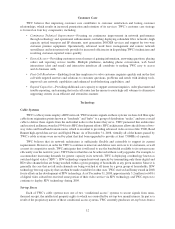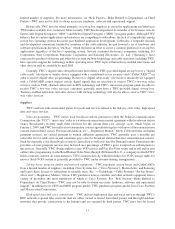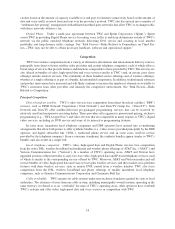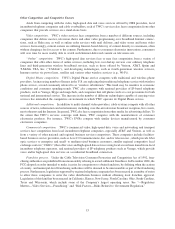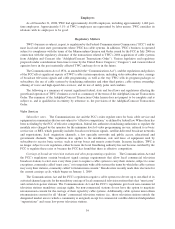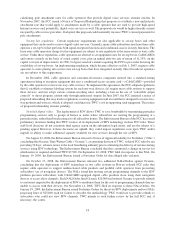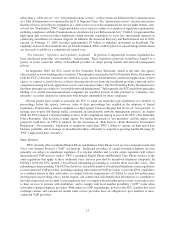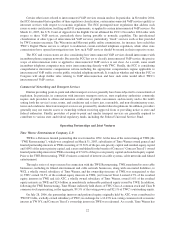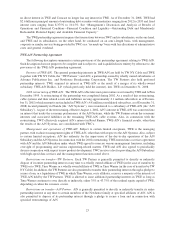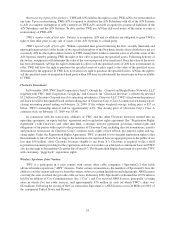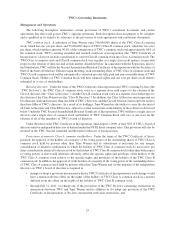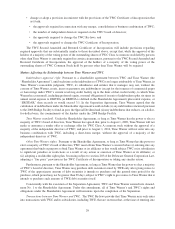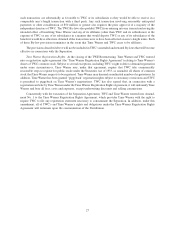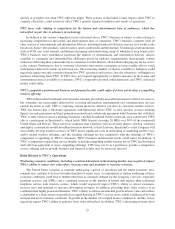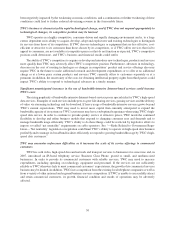Time Warner Cable 2008 Annual Report Download - page 32
Download and view the complete annual report
Please find page 32 of the 2008 Time Warner Cable annual report below. You can navigate through the pages in the report by either clicking on the pages listed below, or by using the keyword search tool below to find specific information within the annual report.Certain other issues related to interconnected VoIP services remain unclear. In particular, in November 2004,
the FCC determined that regardless of their regulatory classification, certain interconnected VoIP services qualify as
interstate services with respect to economic regulation. The FCC preempted state regulations that address such
issues as entry certification, tariffing and E911 requirements, as applied to certain interconnected VoIP services. On
March 21, 2007, the U.S. Court of Appeals for the Eighth Circuit affirmed the FCC’s November 2004 order with
respect to these VoIP services, particularly those having portable or nomadic capability. The jurisdictional
classification of other types of interconnected VoIP services, particularly “fixed” services such as that provided
by TWC remains uncertain. The Wisconsin and Missouri public utility commissions, for instance, have ruled that
TWC’s Digital Phone service is subject to traditional, circuit-switched telephone regulation, while other state
commissions have opened investigations into how such VoIP services should be treated in their respective states.
The FCC and various states are also considering how interconnected VoIP services should interconnect with
incumbent phone company networks. Because the FCC has yet to classify interconnected VoIP service, the precise
scope of interconnection rules as applied to interconnected VoIP service is not clear. As a result, some small
incumbent telephone companies may resist interconnecting directly with TWC. Finally, the FCC is considering
comprehensive intercarrier compensation reform including the appropriate compensation regime applicable to
interconnected VoIP traffic over the public switched telephone network. It is unclear whether and when the FCC or
Congress will adopt further rules relating to VoIP interconnection and how such rules would affect TWC’s
interconnected VoIP service.
Commercial Networking and Transport Services
Entities providing point-to-point and other transport services generally have been subjected to various kinds of
regulation. In particular, in connection with intrastate transport services, state regulatory authorities commonly
require such providers to obtain and maintain certificates of public convenience and necessity and to file tariffs
setting forth the service’s rates, terms, and conditions and to have just, reasonable, and non-discriminatory rates,
terms and conditions. Interstate transport services are governed by similar federal regulations. In addition, providers
generally may not transfer assets or ownership without receiving approval from or providing notice to state and
federal authorities. Finally, providers of point-to-point and similar transport services are generally required to
contribute to various state and federal regulatory funds, including the Federal Universal Service Fund.
Operating Partnerships and Joint Ventures
Time Warner Entertainment Company, L.P.
TWE is a Delaware limited partnership that was formed in 1992. At the time of the restructuring of TWE (the
“TWE Restructuring”), which was completed on March 31, 2003, subsidiaries of Time Warner owned general and
limited partnership interests in TWE consisting of 72.36% of the pro-rata priority capital and residual equity capital
and 100% of the junior priority capital, and a trust established for the benefit of Comcast (“Comcast Trust I”) owned
limited partnership interests in TWE consisting of 27.64% of the pro-rata priority capital and residual equity capital.
Prior to the TWE Restructuring, TWE’s business consisted of interests in cable systems, cable networks and filmed
entertainment.
Through a series of steps executed in connection with the TWE Restructuring, TWE transferred its non-cable
businesses, including its filmed entertainment and cable network businesses, along with associated liabilities, to
WCI, a wholly owned subsidiary of Time Warner, and the ownership structure of TWE was reorganized so that
(i) TWC owned 94.3% of the residual equity interests in TWE, (ii) Comcast Trust I owned 4.7% of the residual
equity interests in TWE and (iii) ATC, a wholly owned subsidiary of Time Warner, owned 1.0% of the residual
equity interests in TWE and $2.4 billion in mandatorily redeemable preferred equity issued by TWE. In addition,
following the TWE Restructuring, Time Warner indirectly held shares of TWC Class A common stock and Class B
common stock representing, in the aggregate, 89.3% of the voting power and 82.1% of TWC’s outstanding equity.
On July 28, 2006, the partnership interests and preferred equity originally held by ATC, were contributed to
TW NY Cable, a wholly owned subsidiary of TWC, in exchange for a 12.43% non-voting common stock economic
interest in TW NY, and Comcast Trust I’s ownership interest in TWE was redeemed. As a result, Time Warner has
22


